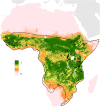Mapping the zoonotic niche of Lassa fever in Africa
- PMID: 26085474
- PMCID: PMC4501400
- DOI: 10.1093/trstmh/trv047
Mapping the zoonotic niche of Lassa fever in Africa
Abstract
Background: Lassa fever is a viral haemorrhagic illness responsible for disease outbreaks across West Africa. It is a zoonosis, with the primary reservoir species identified as the Natal multimammate mouse, Mastomys natalensis. The host is distributed across sub-Saharan Africa while the virus' range appears to be restricted to West Africa. The majority of infections result from interactions between the animal reservoir and human populations, although secondary transmission between humans can occur, particularly in hospital settings.
Methods: Using a species distribution model, the locations of confirmed human and animal infections with Lassa virus (LASV) were used to generate a probabilistic surface of zoonotic transmission potential across sub-Saharan Africa.
Results: Our results predict that 37.7 million people in 14 countries, across much of West Africa, live in areas where conditions are suitable for zoonotic transmission of LASV. Four of these countries, where at-risk populations are predicted, have yet to report any cases of Lassa fever.
Conclusions: These maps act as a spatial guide for future surveillance activities to better characterise the geographical distribution of the disease and understand the anthropological, virological and zoological interactions necessary for viral transmission. Combining this zoonotic niche map with detailed patient travel histories can aid differential diagnoses of febrile illnesses, enabling a more rapid response in providing care and reducing the risk of onward transmission.
Keywords: Boosted regression trees; LASV; Lassa fever; Mastomys natalensis; Species distribution models; Viral haemorrhagic fever.
© The Author 2015. Published by Oxford University Press on behalf of Royal Society of Tropical Medicine and Hygiene.
Figures




References
-
- Frame JD, Baldwin JM Jr., Gocke DJ et al. . Lassa fever, a new virus disease of man from West Africa. I. Clinical description and pathological findings . Am J Trop Med Hyg 1970;19:670–6. - PubMed
-
- Rose JR. An outbreak of encephalomyelitis in Sierra Leone. Lancet 1957;273:914–6. - PubMed
-
- McCormick JB, Webb PA, Krebs JW et al. . A prospective study of the epidemiology and ecology of Lassa fever. J Infect Dis 1987;155:437–44. - PubMed
-
- Lukashevich IS, Clegg JC, Sidibe K. Lassa virus activity in Guinea: distribution of human antiviral antibody defined using enzyme-linked immunosorbent assay with recombinant antigen. J Med Virol 1993;40:210–7. - PubMed
-
- Tomori O, Fabiyi A, Sorungbe A et al. . Viral hemorrhagic fever antibodies in Nigerian populations. Am J Trop Med Hyg 1988;38:407–10. - PubMed
Publication types
MeSH terms
Grants and funding
LinkOut - more resources
Full Text Sources
Other Literature Sources

